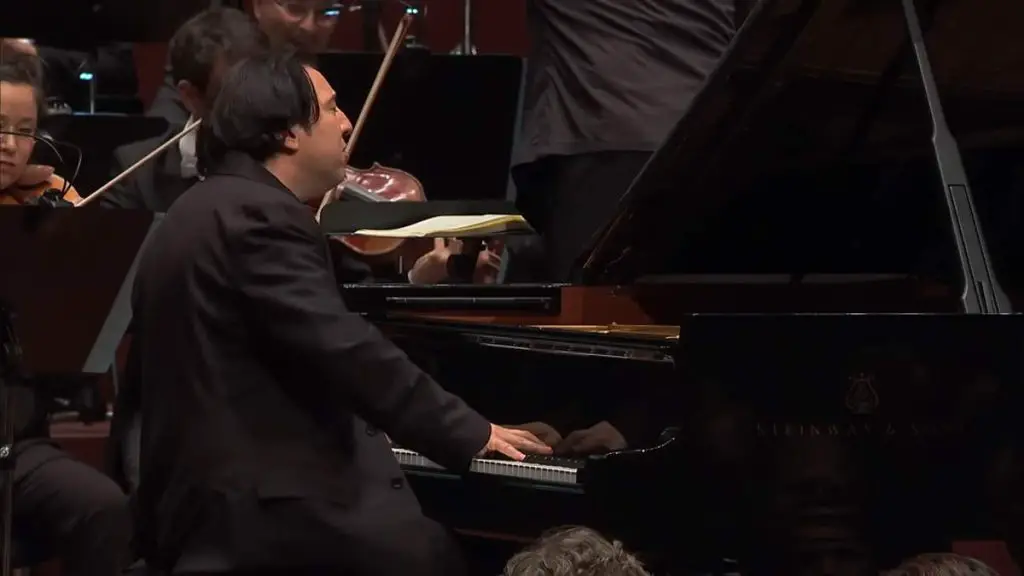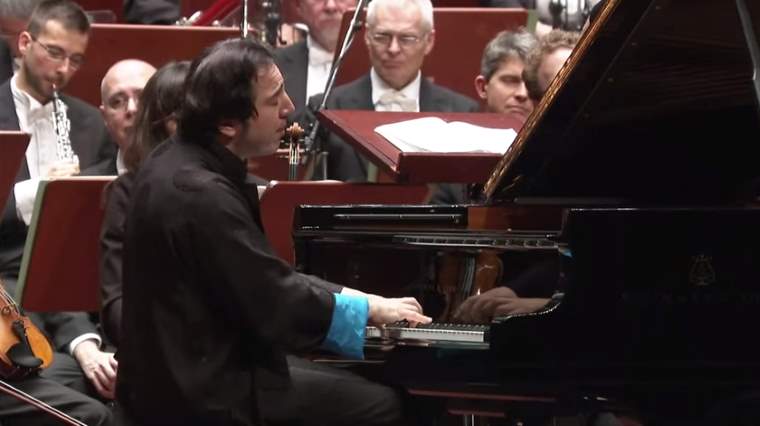Accompanied by the Orchestre National de France, Turkish classical pianist Fazıl Say performs Camille Saint-Saëns’ Piano Concerto No. 2 in G minor, Op. 22. Conductor: Kristjan Järvi. Recorded on October 6, 2014 at the Théâtre du Châtelet (Paris).
Saint-Saëns’ Piano Concerto No. 2
The Piano Concerto No. 2 in G minor, Op. 22 by Camille Saint-Saëns is a remarkable composition that showcases the virtuosity and musical genius of the French composer. Completed in 1868, it stands as one of Saint-Saëns’ most beloved and frequently performed piano concertos. This concerto was dedicated to Madame A. de Villers (née de Haber), a significant figure in Saint-Saëns’ life during that period.
The premiere of the concerto took place on May 13, with Saint-Saëns himself as the soloist and the eminent conductor Anton Rubinstein leading the orchestra. Interestingly, Saint-Saëns had an incredibly tight timeline to compose the concerto, as he wrote it within a mere three weeks. Consequently, this constrained timeframe left him with very little preparation time for the premiere, which may have contributed to its initial lack of success.
The Piano Concerto No. 2 exhibits a fascinating amalgamation of various stylistic elements, displaying Saint-Saëns’ eclectic approach to composition. In fact, these capricious changes in style prompted Zygmunt Stojowski to jest that the concerto “begins with Bach and ends with Offenbach.” This clever remark alludes to the concerto’s diverse musical palette, incorporating both the classical elegance and intricate counterpoint of Bach’s era, as well as the lively and often humorous character associated with Offenbach’s works.
Movements
Saint-Saëns’ Piano Concerto No. 2 is structured in the conventional three-movement form. With start times in the video:
- [00:57] Andante sostenuto (in G minor and sonata form)
- [13:29] Allegro scherzando (in E-flat major and sonata form)
- [19:11] Presto (in G minor and sonata form)
1. Andante sostenuto
The first movement of Saint-Saëns’ Piano Concerto No. 2 in G minor, Op. 22 is a captivating and emotionally charged musical journey that showcases the composer’s mastery of composition and his ability to blend various stylistic elements seamlessly.
The movement commences with a mesmerizing display of virtuosity as the piano takes center stage, delivering a long improvisational introduction reminiscent of a Bach fantasia. The soloist’s fingers dance across the keys, exploring intricate figurations and showcasing technical brilliance. This opening sets the stage for what is to come, immersing the listener in a world of musical exploration and expression.
As the orchestra enters, a sense of restlessness and melancholy permeates the air. The piano solo continues to dominate the proceedings, introducing the first theme, which is characterized by its introspective and pensive nature. Remarkably, Saint-Saëns drew inspiration for this theme from his student Gabriel Fauré’s abandoned Tantum ergo motet, infusing the concerto with a sense of artistic connection and homage.
Following the presentation of the first theme, a brief second theme emerges, providing a momentary respite from the melancholic atmosphere. This theme introduces a contrasting mood, introducing a glimmer of hope and optimism. However, the tranquility is short-lived as the music transitions into a middle section marked by increasing degrees of animato. Here, the intensity builds, and the emotional landscape deepens, drawing the listener further into the intricate musical tapestry.
In a powerful moment, the main theme resurfaces, this time in a fortissimo statement, commanding attention and reinforcing its significance. The soloist and orchestra engage in a spirited dialogue, intertwining melodies, and harmonies with a sense of urgency and passion. The interplay between the piano and orchestra showcases the inherent tension and dynamic range of the concerto.
As the movement progresses toward its culmination, the soloist is granted a long ad libitum cadenza, allowing for further exploration and personal expression. The cadenza serves as a moment of virtuosic display and artistic freedom for the soloist, who weaves together dazzling runs, trills, and expressive gestures, captivating the audience with their technical prowess and musical sensitivity.
In a stroke of compositional brilliance, the Bach-like opening motif returns in the coda, bringing the movement full circle and providing a sense of unity and closure. This closing gesture serves as a musical anchor, reminding the listener of the concerto’s initial improvisational nature and paying homage to the Baroque master, Johann Sebastian Bach.
The first movement of Saint-Saëns’ Piano Concerto No. 2 in G minor is a rich and multifaceted musical experience. It combines elements of improvisation, introspection, virtuosity, and homage to create a captivating and emotionally charged journey for both the performers and the listeners. Saint-Saëns’ masterful composition and expressive writing ensure that this movement remains a cherished and frequently performed gem within the piano concerto repertoire.
2. Allegro scherzando
The second movement of Saint-Saëns’ Piano Concerto No. 2 in G minor, Op. 22 is a delightful departure from the traditional slow and lyrical adagio commonly found in concerto movements. Instead, it takes on the character of a scherzo, injecting playful and lighthearted energy into the composition. This movement showcases Saint-Saëns’ musical wit and his ability to infuse his compositions with a sense of cleverness and charm.
Set in E-flat major, the second movement immediately captivates the listener with its mercurial piano part, marked leggieramente, which means “lightly” or “with agility.” The soloist’s fingers dance across the keys, executing rapid passages and sparkling figurations with precision and grace. This agile and nimble piano writing contributes to the movement’s buoyant and spirited atmosphere.
The movement unfolds with the introduction of two main themes, both cleverly crafted and light-hearted in nature. These themes possess a certain whimsical quality, characterized by their melodic charm and rhythmic vivacity. Saint-Saëns masterfully weaves together these themes, allowing them to interact and playfully converse with each other throughout the movement.
The energetic and delicate personality of this movement is a trademark of Saint-Saëns’ musical style, and it can be traced back to his penchant for musical wit. This facet of his compositional voice is most famously observed in his renowned work, Le Carnaval des Animaux (The Carnival of the Animals). In this composition, Saint-Saëns playfully depicts various animals through music, employing witty melodies and clever musical ideas. The same light-hearted and humorous approach can be heard in the second movement of Piano Concerto No. 2, further emphasizing the composer’s affinity for whimsy and charm.
As the movement progresses, Saint-Saëns explores different variations and developments of the main themes, creating an ever-evolving musical landscape. The piano and orchestra engage in a spirited dialogue, exchanging motifs and building upon each other’s ideas. The interplay between the soloist and the orchestra highlights the seamless integration of technical virtuosity and musical expression, creating a captivating and engaging musical conversation.
Despite its playful and light-hearted character, the second movement does not lack depth or emotional resonance. Saint-Saëns’ compositional genius allows him to strike a delicate balance between the exuberant and the introspective, infusing moments of tenderness and introspection amidst the spirited musical fabric.
In the second movement, listeners are transported to a realm of musical enchantment, where clever melodies, agile piano passages, and a sense of joyful whimsy converge. This movement serves as a testament to Saint-Saëns’ musical versatility and his ability to infuse his compositions with a distinct personality. The playful and energetic nature of this movement adds a touch of vivacity to the concerto, showcasing Saint-Saëns’ unique musical voice and contributing to the enduring popularity of this remarkable work.
3. Presto
The finale of Saint-Saëns’ Piano Concerto No. 2 in G minor, Op. 22 brings the concerto to a thrilling and exhilarating conclusion. Returning to the home key of G minor, this movement maintains the fast-paced energy established in the preceding movement, propelling the listener through a fiery and spirited musical journey.
In contrast to the scherzo-like character of the second movement, the third movement takes on the form of an extremely fast and intense saltarella, a lively Italian dance. Structured in sonata form, this movement is marked by its rapid tempo and the presence of a strong triplet figure that infuses the music with a relentless sense of forward motion. The constant drive and urgency in this movement contribute to its exhilarating nature, captivating the listener from the very beginning.
From the outset, both the orchestra and the soloist embark on a presto journey, rushing tumultuously together. The music gains volume and momentum as the interplay between the piano and the orchestra becomes increasingly intense and electrifying. Saint-Saëns skillfully weaves together melodic motifs and rhythmic patterns, building tension and excitement as the movement unfolds.
As the movement progresses, the whirlwind of sound reaches its peak, with the soloist and orchestra engaging in a virtuosic display of technical prowess and musical intensity. The piano unleashes a torrent of G minor arpeggios, creating a thrilling and powerful conclusion to the concerto. The relentless energy and momentum of the movement leave no room for respite, propelling the listener forward until the final triumphant notes resound.
The third movement of Saint-Saëns’ Piano Concerto No. 2 showcases the composer’s ability to create a dynamic and captivating finale. The combination of the rapid tempo, fiery rhythms, and the strong triplet figure creates a sense of exhilaration and musical fireworks. The interplay between the soloist and the orchestra, fueled by their shared momentum, ensures an electrifying and dramatic conclusion to the concerto.
As the whirlwind of G minor arpeggios subsides, the concerto concludes with a sense of satisfaction and awe. Saint-Saëns’ mastery of orchestration and his ability to harness the full potential of the piano and orchestra in tandem are evident in this movement. The symphonic scope of the composition, along with its virtuosic demands, make it a thrilling and demanding piece for both the soloist and the accompanying ensemble.
The third movement of Saint-Saëns’ Piano Concerto No. 2 serves as a testament to the composer’s brilliance and his ability to captivate audiences with his dynamic and expressive musical language. From the relentless energy and fiery tempo to the breathtaking whirlwind of G minor arpeggios, this movement leaves a lasting impression, bringing the concerto to a grand and exhilarating close.
Sources
- Piano Concerto No. 2 (Saint-Saëns) on Wikipedia


